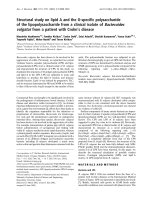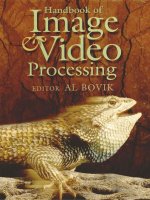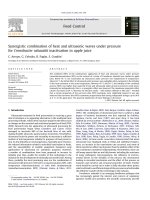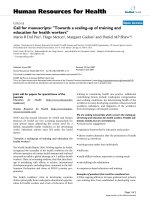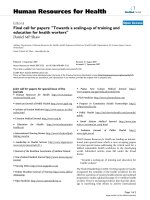Study on establishing a mining group of deposit and an exploration grid pattern for lead - zinc ore in Ban Lim area, Cao Bang province
Bạn đang xem bản rút gọn của tài liệu. Xem và tải ngay bản đầy đủ của tài liệu tại đây (1.33 MB, 13 trang )
38
Journal of Mining and Earth Sciences Vol. 61, Issue 3 (2020) 38 - 50
Study on establishing a mining group of deposit and
an exploration grid pattern for lead - zinc ore in Ban
Lim area, Cao Bang province
Khang Quang Luong 1, *, Hung The Khuong 1, Tuong Van Nguyen 2, Thu Thi Le 1
1 Faculty of Geosciences and Geoengineering, Hanoi University of Mining and Geology, Vietnam
2 Dong Bac Geological
Division, Cach Mang Thang Tam road, Thai Nguyen City, Thai Nguyen, Vietnam
ARTICLE INFO
ABSTRACT
Article history:
Received 05th Feb. 2020
Accepted 26th May 2020
Available online 30th June 2020
Ban Lim area in Cao Bang province has proposed a high potential of leadzinc resources, which have occurred in different rocks of geological
formation. The paper-based on collecting, synthesizing, and geological
processing data. In addition, mathematical methods were also applied to
recognize studied objects of the exploration process using a quantitative
description. The results how that the lead-zinc orebodies in Ban Lim area
mainly occurred in lens-shaped and distributed in layered surfaces of the
dolomitized limestone of Coc Xo formation. The average lead-zinc content
of the orebodies is in a range from 3.27% to 8.33%; its coefficient of
variation (Vc) is in a range from 13.71% (evenly) to 137.92% (very
unevenly). Generally, the lead-zinc contents of the orebodies in Ban Lim
area mainly comply with the standard normal distribution. The average
thicknesses of the orebodies are in a range from 0.92 m to 6.48 m, its
coefficient of variation (Vm) is in the range from 8.7% (stable) to 132.95%
(very unstable). Quantitative calculation results have shown that Ban Lim
lead-zinc deposit belongs to group III of deposits. For the exploration of
this type of minerals, it is recommended to use a linear grid pattern.
Appropriate exploration grid pattern for the 122 category reserve is
(60÷80) m × (30÷40) m. These calculated results are well- documented
foundations that allow suggesting a mining group of deposit and an
exploration grid pattern for lead-zinc ore in Ban Lim area and other leadzinc deposits occurring in similar geological settings.
Keywords:
Ban Lim area,
Exploration grid pattern,
Lead-zinc ore,
Mining group.
Copyright © 2020 Hanoi University of Mining and Geology. All rights reserved.
1. Introduction
_____________________
*Corresponding author
E-mail:
DOI: 10.46326/JMES.2020.61(3).04
According to Provisions of the Vietnam
Ministry of Natural Resources and Environment
(2006), deposits are categorized by their
complexity, size, and shape. From this concept,
Khang Quang Luong and et al./Journal of Mining and Earth Sciences 61 (3), 38 - 50
mineral deposits can be divided into four groups.
Group I: comprised of deposits that have no
structural complexity, uniform thickness, and
homogeneous grades. They are often large
deposits, simple in form, with uniform
distribution of minerals. A normal density of drill
holes allows the definition of a high level of 121
reserves. Deposits of Group II are more complex
in structure, non-uniform thickness, and
significant grade variability. They are large
deposits with different, sometimes complicated
forms and uneven distribution of minerals. Only
up to 121 category reserves may be defined with
a normal grid of drill holes. Group III consists of
deposits that have a highly complex structure,
significant variations in thickness, and very
uneven grade distribution. These deposits are
smaller sized with uneven distribution of
minerals. Drill holes can only establish 122
reserves. Finally, Group IV deposits - extremely
complex structure, extreme variations in
thickness, and grade distribution. They are
smaller sized deposits or small pocket deposits
with even more complex shapes. Drilling in
combination with underground workings is
necessary to establish category 122 reserves.
Geological mapping works have revealed
several lead-zinc ore deposits in Cao Bang
province. However, most of these deposits are
proposed as small to medium in size, excepted for
Ban Lim area that is evaluated over prospective
(Do Quoc Binh, 2004; Nguyen Van Phu, 2019). Up
to present, there are no systematically researchs
on geochemical characteristics, mineralization
processes as well as the mining exploration group
with adequate grids for the lead-zinc ore type in
the area. Therefore, the results of geological data
processing and mathematical methods for Ban
Lim area presented here will play an important
role for mineral exploration and mining in the
future.
2. General geological features of Ban Lim
area, Cao Bang province
The lithology of Ban Lim area is composed
mainly of carbonate intercalated with gray, light
gray to dark-gray terrigenous sedimentary rocks
that were suggested as early Devonian age named
Coc Xo formation (Nguyen Van Phu, 2019). In the
center of Ban Lim area, effusive rocks of felsic and
39
rhyolite (undefined age) are exposed in lensshaped, extending in the northwest-southeast
trending (Figure 1). Quaternary sediment
distributes along the river and Ban Lim valley.
Having studied the structure of the Ban Lim
area, the previous work has proved a monoclinal
structure extends in a northwest-southeast
direction (Phung Quoc Tri, 2013). Three fault
systems also have been mapped in the area
(Nguyen Van Phu, 2019) which are northwestsoutheast, northeast-southwest, and near a westeast trending system of which the northwestsoutheast fault system has been supported as the
major faults and controlled the main structure of
Ban Lim area (Nguyen Van Phu, 2019). Most of the
lead-zinc orebodies discovered in Ban Lim area
are controlled by this fault system (Phung Quoc
Tri, 2013; Nguyen Van Phu, 2019). The northeastsouthwest and west-east fault systems are
younger and displaced the orebodies that make
the area complicated.
3. Methods
Establishing a mining group of deposit and an
exploration grid within a study area can be
characterized by statistical measures and
properties describing the pattern, as well as by
indicators of more local properties of the
orebodies as shape, morphology, and structure.
The former can be described by a series of
summary statistics providing information on the
morphological and structural orebodies.
Estimation of average mineral deposit
parameters has been extensively used in
quantitative mineral resource assessments to
estimate numbers of exploration works in a study
area based on statistical methods and the theory
of random functions (Wellmer, 1998). In contrast,
methods for establishing an exploration grid
pattern have rarely been applied to investigate
mineral deposit patterns (Saikia & Sarkar, 2006).
On the combination of geological data being
collected, synthesized, and processed from
previous documents, the authors have applied
geomathematical methods to improve the
efficiency
of
evaluation
of
lead-zinc
mineralization characteristics in Ban Lim area.
3.1. Establishing a mining group of deposit
40
Khang Quang Luong and et al./Journal of Mining and Earth Sciences 61 (3), 38 - 50
3.1.1. One-dimensional statistical mechanics model
3.1.2. Morphological and structural orebodies
This method is used in processing
geochemical data for the descriptive statistical
distribution of geological parameters such as
compositions, thickness, technical properties, and
physical parameters of orebodies. The results are
used to determine the average value, variance,
coefficient of variation of geological parameters.
This would ensure process efficiency as well as
truthfulness, and non-error in data processing
and lending to ensure reliability. From the
probability distribution function that allows
determining the probability of random numbers
appearing in the arbitrary selection range, the
method provides a detailed content in Wellmer
(1998), Luu Cong Tri (2020).
Ore-bearing coefficients (Kp): The ore-bearing
coefficient is determined according to the
thickness, area, and length of an orebody.
By calculating the orebody thickness:
∑𝑁 𝑚𝑖
𝑖=1 𝑀𝑖
𝐾𝑝𝑚 = ∑𝑖=1
𝑁
(1)
where mi - thickness of payable ore, which is
determined in the i-th exploration work; Mi thickness of lead - zinc ore bearing rock layer; N number of exploration projects.
By calculating the ore area:
𝐾𝑝𝑠 =
∑𝑁
𝑖=1 𝑆𝑝
𝑆
(2)
Figure 1. Simplified geological map of Ban Lim area, Cao Bang province (modified from Nguyen Van Phu et
al., 2019).
Khang Quang Luong and et al./Journal of Mining and Earth Sciences 61 (3), 38 - 50
where ∑𝑁
𝑖=1 𝑆𝑝 - total orebodies area limit in
the exploration region; N - number of orebodies; S
- the area of the exploration object.
By calculating the ore piece:
𝐾𝑃𝐿 =
∑𝑁
𝑖=1 𝐿𝑃
∑𝑁
𝑖=1 𝐿𝑐
(3)
where ∑𝑁
𝑖=1 𝐿𝑃 - total length of orebodies;
total general length of the exploration
lines.
Coefficients of broken ore (Knp) is determined
by the formula:
∑𝑁
𝑖=1 𝐿𝑐 -
𝐾𝑛𝑝 =
𝑖
𝐾𝑝𝑚
(4)
with i - number of broken ore is determined
by exploration lines section; 𝐾𝑝𝑚 - ore-bearing
coefficients.
Coefficients of morphological anisotropy () of
orebodies on the mapping are determined by:
𝐴
(5)
𝐵
with A - orebody thickness is determined in
mapping; B - orebody width is determined in
mapping.
Coefficients of the ore dressing () are
determined by the formula:
=
𝛽=
𝐶𝑡𝑏
𝐶𝐶𝑁
(6)
with Ctb - mean Pb+Zn contents of payable
orebodies; CCN - selected minimum economic
content of ore.
Boundary modules are determined on the
basis by comparing the actual circumference and
circumference of the orebody in geometric form.
The complexity degree of the orebody boundary
is determined by the formula:
𝑒𝜑
𝑀𝐾 =
(7)
𝐿𝜑
4.7𝑎 + 1.5 − 1.77√𝐿𝜑
𝑎
In which: a - half of the longest boundary (m);
L - the perimeter of the orebody is converted to
an ellipse; e - actual circumference of the
orebody.
Orebody shaped index () is calculated as:
𝜑=
41
𝑉𝑀𝐾
𝐾𝑐𝑐
(8)
in which, V - coefficient of variation of payable
orebody thickness (%); Kcc - coefficient of
complexity orebody structure,
𝑚𝑘 𝑛𝑘
𝐾𝑐𝑐 = 1 −
(9)
𝑚𝑞 𝑛𝑞
with mk - total mean thickness of intercalated
layers in orebody; nk - total number of
intercalated layers in orebody; mq - total mean
thickness of ore beds; nq - total number of ore
beds.
3.2. Establishing an exploration grid pattern
3.2.1. Statistical methods
The given area of estimation reserves, the
errors of estimated metal reserves are
determined as formulas:
𝛥𝑝 = √𝛥2𝑚 + 𝛥2𝑐 + 𝛥2𝑑 + 𝛥2𝑠
∆𝑥 =
∆𝑆 =
𝑡. 𝑉𝑥
√𝑁
𝑆2
. 100%
4𝑆1
(10)
(11)
(12)
where m, c, d, s - relative standard errors
of mean thickness, mean content, orebody area,
and mean bulk density of ore; S1 - interpolated
orebody area; S2 - extrapolated orebody area.
Relative standard errors of bulk density (d)
are common, very least errors, and skipping.
Exploratory data analysis of lead - zinc contents
are generated gross errors and random, and it is
lending to mean contents are determined as:
𝛥𝑐′ = √𝛥2𝑐 + 𝛥2𝑝𝑡
(13)
with pt - random errors in sample analysis.
Estimation for the density of exploration grid
by mathematical statistics. Kazdan (1977)
declared that exploration results meet reliability
requirements when an error of the reserve
parameters.
∑ 𝛥 = √𝛥2 𝑚 + 𝛥2 𝑐 + 𝛥2 𝑑 + 𝛥2 𝑠 ≤ 𝛥𝑐𝑝 (14)
42
Khang Quang Luong and et al./Journal of Mining and Earth Sciences 61 (3), 38 - 50
For group III deposits, to meet the
requirement of calculating the 122 category
reserves to ensure safety, it is necessary to select
the relative reserves of allowable reserve
according to the current regulations in the range
of 30÷50%. Therefore, the number of exploration
works that are necessary to control orebodies can
be determined by the formula:
(𝑉 2 𝑚 + 𝑉 2 𝑐 )𝑡 2
𝑁≥
𝛥2 𝑐𝑝
(15)
or following point reserves:
𝑉 2𝑞 . 𝑡 2
𝑁≥ 2
𝛥 𝑐𝑝
(15𝑎)
where, Vm, Vc, Vq - coefficient of variation in
thickness, contents, and point reserves of
estimated orebodies; Δcp - permissible error (30 ÷
50%); t - probability factor (t = 2 corresponding to
P = 0,95). In fact, an exploration often encounters
orebody, which is often distorted, many
researchers recommend adding distortion
coefficients to the orebody and taking the value of
0.15. Therefore, the number of specific works is
1.15 N.
Pogrebiski (1973) summed up that when
mineral deposits have a coefficient of variations in
thickness and content over 80%, the number of
works calculated by statistical methods are often
larger than reality. Conversely, if their coefficient
of variations is less than 40%, the number of
calculation works will smaller. In the case of
changes in the coefficient of variation in the range
of 60÷80%, the method usually gives good results.
Therefore, the density of exploration grid (So) is
calculated by the formula:
𝑆
𝑆0 =
(15b)
𝑁
with So = a x b; a = 0.93√𝑆𝑜 ; b = 1.07√𝑆𝑜 ;
where, S - orebody area; N - number of exploration
works; a - strike line; b - dip direction.
3.2.2. Applied methods of the theory of random
functions
The stable random function is featured by
correlation function Kx(h), depending on range,
observed direction, and correlation function of
the norm - R(h). The formula determines the
correlation function:
⃗)
𝐾𝑥 (ℎ
=
1
N-h
N-h
∑[𝑓(𝑥𝑖 )- E(𝑋)][𝑓(𝑥ith )-E(𝑋)]
(16)
i=1
The correlation function of the norm is
determined by the formula:
𝑅(ℎ) =
⃗)
𝐾𝑥 (ℎ
𝜎𝑥2
(16a)
To determine the influence zone size (H) or
determined domain that allows interpolation,
oscillation, and random transformation, the
authors carry out the construction of correlation
plots.
R*(h) = e-α.h with α - coefficient of variation in
variability zone; h - observed range.
Constructed plots of function:
2σ𝑟 =
2[1-R∗ℎ ]
√𝑁
(16b)
Anisotropy coefficient (I) is defined as:
I=
𝐻hd
𝐻đp
(16c)
where Hđp - size of the influence zone
determined in the strike line; Hhd - size of the
influence zone defined in dip direction.
The density of exploration grid (So) is
calculated by the formula:
So = Hhd × HN
(17)
Number of required exploration works for
assessment of orebody is defined as:
𝑁=
𝑆
𝑆0
(18)
If coordinates (xi, yi) of the collection point
need to convert to coordinates (xk, yk) of the grid
cell, this conversion is done according to the
formula:
𝑍𝑘 =
∑𝑛i=1
Zi
Di
∑𝑛i=1
1
(19)
Di
Where Zk - average value of the study
parameter at k point of the established base cell;
Dik - distance from point k to the closest point of Zi
value.
Khang Quang Luong and et al./Journal of Mining and Earth Sciences 61 (3), 38 - 50
4. Results and discussions
4.1. Characteristics of lead-zinc bodies
Rooted from previous synthetic documents
(Do Quoc Binh, 2004; Phung Quoc Tri, 2013;
Nguyen Van Phu, 2019), and incorporating
additional research materials, the authors allow
further clarification of the distribution
characteristics, structural and morphological
characteristics, relationships and exist at a depth
of orebodies in the study area.
The results of this study indicate that the
lead-zinc bodies are mainly lens-shaped, and
bulge along the strike line of the orebody. Ore
exposures are complicated and changing both
quantity and shape very much. Lead-zinc ores
have occurred in associated with thick - to
medium-bedded dolomitized limestone. Ore
compositions are fairly evenly distributed along
the strike line and dip direction of orebodies. Ore
43
compositions are commonly an irregular lattice
that is distributed in the layered surface of
dolomitized limestone. Orebody dip to
southwestward with dip angle is varying from 35o
to 450. The typical results of major orebodies are
listed in Table 1.
4.2. Estimation of exploration group for leadzinc deposit in Ban Lim area
4.2.1. Statistical characteristics of lead-zinc
orebody parameters
Statistical treatment of content and thickness
of the lead-zinc orebody in Ban Lim area is listed
in Table 2.
Results from Table 2 show that in all
orebodies, the mean lead-zinc content is in a
range from 3.27% to 8.33%, its coefficient of
variation (Vc) is in the range from 13.71%
(evenly) to 137.92% (very unevenly).
Table 1. General characteristics of lead-zinc bodies in Ban Lim area.
No
1
2
3
4
5
6
7
8
9
10
11
12
13
14
15
16
17
18
19
20
21
Size (meters)
Ore
Extend along with Extend along with dip
bodies
strike line
direction (from-to)
TQ.1
130
30-40
TQ.2
180
40-55
TQ.3
180
15
TQ.4
170
45
TQ.4a
170
35-45
TQ.5
135
40
TQ.5a
135
40-45
TQ.6
145
40-45
TQ.6a
155
30-50
TQ.7
145
35-40
TQ.8
145
35-40
TQ.8a
140
45
TQ.9
140
45
TQ.10
140
45
TQ.11
150
45
TQ.12
140
35-50
TQ.13
170
35-45
TQ.13a
160
40-50
TQ.14
160
40-50
TQ.15
145
45
TQ.16
145
45
Average
thickness
0.99
1.55
3.18
6.15
6.48
5.98
3.80
3.42
4.51
2.60
1.72
1.65
3.45
1.46
1.25
1.35
2.62
3.01
3.43
0.92
1.83
Orebody features
Strike/dip
Shape
(degree)
lens-shaped
240/30
lens-shaped
240/48
lens-shaped
250/15
lens-shaped 230-240/41
lens-shaped 230-240/35
lens-shaped 235-240/41
lens-shaped
230/36
lens-shaped
240/40
lens-shaped
240/37
lens-shaped
240/41
lens-shaped
230/42
lens-shaped
240/43
lens-shaped
230/42
lens-shaped
240/40
lens-shaped
230/50
lens-shaped
250/38
lens-shaped 250-280/40
lens-shaped
250/45
lens-shaped
250/45
lens-shaped
250/43
lens-shaped
250/40
44
Khang Quang Luong and et al./Journal of Mining and Earth Sciences 61 (3), 38 - 50
Table 2. Statistical characteristics of lead-zinc content of the orebodies.
Orebody
TQ.1
TQ.2
TQ.3
TQ.4
TQ.4a
TQ.5
TQ.5a
TQ.6
TQ.6a
TQ.7
TQ.8
TQ.8a
TQ.9
TQ.10
TQ.11
TQ.12
TQ.13
TQ.13a
TQ.14
TQ.15
TQ.16
Average
content
1.09
5.55
5.81
5.17
4.40
4.76
3.74
1.48
3.95
5.65
5.17
8.20
4.13
6.85
4.87
4.70
8.32
6.96
6.07
8.33
5.55
Pb + Zn contents (%)
Coefficient of
Variance (σ2)
variation (Vc)
0.18
39.06
11.35
60.72
0.63
13.71
9.61
59.92
4.29
47.09
1.74
27.71
3.18
47.65
0.33
38.67
2.61
40.89
15.66
70.03
2.24
28.94
26.28
62.53
3.89
47.74
15.51
57.52
7.82
57.48
7.00
56.31
35.27
71.34
92.26
137.92
12.59
58.48
25.32
60.42
4.79
39.41
On the whole, the lead-zinc contents of the
orebodies in Ban Lim area are mainly complied
with standard normal distribution, except for
orebodies of TQ.1 and TQ.6 are lognormal
distribution.
As mentioned in Table 3, an average
thickness of the lead-zinc orebodies varies from
0.92 m to 6.48 m, its coefficient of variation (Vm) is
in the range of 8.7 ÷ 132.95%, their distributions
belong to stable to very unstable. All orebody
thicknesses mainly comply with the standard
normal distribution.
4.2.2. Characteristics of continuous mineralization
Features of continuous mineralization are
one of the main factors that influence the degree
of ease of available exploration geology.
Therefore, a quantitative study of the continuity of
lead-zinc ore mineralization by applying formulas
(1), (2), and (3) are listed below.
For investigated lead-zinc orebodies, the
authors are going to estimate the degree of
tA
tE
1.93
-0.38
0.25
1.82
1.42
-0.36
0.94
0.93
-0.02
0.88
-0.85
1.25
1.13
1.82
1.48
0.30
1.88
2.70
0.70
1.30
1.06
1.65
-1.13
0.44
1.97
1.19
0.06
-0.13
-0.6
-1.32
-0.92
0.47
0.85
0.83
1.27
1.33
-1.06
-0.12
3.44
0.81
1.28
0.60
Distribution pattern
Lognormal standard
Normal standard
Normal standard
Normal standard
Normal standard
Normal standard
Normal standard
Lognormal standard
Normal standard
Normal standard
Normal standard
Normal standard
Normal standard
Normal standard
Normal standard
Normal standard
Normal standard
Normal standard
Normal standard
Normal standard
Normal standard
broken ore, morphological anisotropy, and
coefficients of ore dressing by applying formulas
(4), (5), and (6).
The results presented in Table 4 point out
that lead-zinc ore mineralization is of
discontinuous and continuous types, their
coefficients of broken ore are complicated,
especially in the orebody TQ.5 (Knp=108.11).
Major lead-zinc bodies are commonly anisotropy
shape (as seen in the TQ.3, TQ.4, TQ.4a, TQ.5,
TQ.5a, TQ.6, TQ.6a, TQ.7, TQ.9, TQ13, TQ.14),
except for the orebodies TQ.1, TQ.2, TQ.6, TQ.7,
TQ.8, TQ.8a, TQ.10, TQ.11, TQ.12, TQ.13a, TQ.15,
and TQ.16. In most cases, lead-zinc contents
belong to the base and medium; its coefficients of
ore dressing are in a range from 0.94 (TQ.1) to
2.38 (TQ.13).
4.2.3. Complexity degree of orebody boundary
module and orebody shaped index
The shapes, strike, dip formats, and
complexity degree of structural orebodies have
Khang Quang Luong and et al./Journal of Mining and Earth Sciences 61 (3), 38 - 50
been estimated by applying (7), (8), and (9).
Calculated results of the complexity degree of the
orebody boundary module and orebody shaped
index are listed in Table 5.
Table 5 shows the complexity and shaped
index of lead-zinc orebodies that vary from simple
to complex. In Ban Lim area, research results on
the quantitative changes of lead-zinc ore
mineralization point out the thickness of
orebodies is from medium to small size, its shape
changes from relatively complicated to more
complicated. Coefficients of thickness variation of
orebodies are stable to unstable types with
discontinuous mineralization. Lead-zinc contents
of Ban Lim deposit are even to unevenly
distribution: they also belong to the base and
medium contents and covered by burden.
Orebodies are relatively gentle dips. Found from
the characteristics of Ban Lim lead-zinc orebodies,
and inferred from the documents of Vietnam
Ministry of Natural Resources and Environment
(06/2006/QĐ-BTNMT), the authors, therefore,
45
categorize Ban Lim lead-zinc deposit to group III.
4.2.4. Definition of exploration grid pattern for Ban
Lim lead-zinc deposit
The definition of a rational exploration grid,
also known as optimization of the exploration
grid, is done on the basis of the documents of
exploration geological parameters. They are
important to consider explorer objects and
depend
on
mining-geological
structure
characteristics. In most cases, point reserves
(meters, %) can be used as the key of geological
parameters. If the thickness or important
elements of orebodies are the largest variations,
the selection of the exploration grid will be
depended on the characteristics of the largest
orebody.
* Evaluating the effectiveness of exploration system
Relative errors of lead-zinc bodies are
calculated by equations (10), (11), (12), and (13).
The results are listed in Table 6.
Table 3. Statistical characteristics of lead-zinc orebody thicknesses.
Orebody
TQ.1
TQ.2
TQ.3
TQ.4
TQ.4a
TQ.5
TQ.5a
TQ.6
TQ.6a
TQ.7
TQ.8
TQ.8a
TQ.9
TQ.10
TQ.11
TQ.12
TQ.13
TQ.13a
TQ.14
TQ.15
TQ.16
Average
0.99
1.55
3.18
6.15
6.48
5.98
3.80
3.42
4.51
2.60
1.72
1.65
0.80
1.46
1.25
1.35
2.62
3.01
3.43
0.92
1.83
True thickness parameters (meter)
Variance
Coefficient of
tA
(σ2)
variation (Vm)
0.03
18.90
1.52
1.78
86.11
2.19
3.82
61.44
1.28
32.99
93.37
1.23
37.25
94.22
0.76
28.21
88.81
2.06
3.99
52.58
0.17
4.98
65.25
1.92
15.51
87.42
0.34
2.34
58.78
(0.03)
0.12
20.45
1.23
0.32
34.25
0.24
0.89
117.23
0.79
0.18
29.02
0.49
0.43
52.50
0.43
0.06
17.69
(0.36)
7.48
104.34
4.26
1.22
36.75
0.61
20.80
132.95
1.94
0.01
8.70
(0.64)
0.25
27.13
1.42
tE
1.77
2.44
0.94
(0.48)
(1.08)
(0.14)
(0.67)
0.85
(1.09)
(1.38)
1.28
0.62
-0.24
(0.57)
(0.74)
(1.06)
5.81
(0.15)
2.11
(0.14)
1.24
Distribution pattern
Normal standard
Normal standard
Normal standard
Normal standard
Normal standard
Normal standard
Normal standard
Normal standard
Normal standard
Normal standard
Normal standard
Normal standard
Lognormal standard
Normal standard
Normal standard
Normal standard
Normal standard
Normal standard
Normal standard
Normal standard
Normal standard
46
Khang Quang Luong and et al./Journal of Mining and Earth Sciences 61 (3), 38 - 50
Table 4. Calculated results of lead-zinc ore-bearing coefficients.
No
1
2
3
4
5
6
7
8
9
10
11
12
13
14
15
16
17
18
19
20
21
Orebody
TQ.1
TQ.2
TQ.3
TQ.4
TQ.4a
TQ.5
TQ.5a
TQ.6
TQ.6a
TQ.7
TQ.8
TQ.8a
TQ.9
TQ.10
TQ.11
TQ.12
TQ.13
TQ.13a
TQ.14
TQ.15
TQ.16
Orebody thickness (Kpm)
0.022
0.023
0.032
0.108
0.130
0.009
0.114
0.222
0.068
0.039
0.026
0.016
0.095
0.029
0.019
0.010
0.111
0.053
0.043
0.011
0.018
Ore area (KpS)
0.0004
0.0001
0.0002
0.0003
0.0002
0.0003
0.0002
0.0005
0.0002
0.0002
0.0001
0.0001
0.0002
0.0003
0.0001
0.0001
0.0003
0.0002
0.0001
0.0001
0.0002
Ore piece (KpL)
0.021
0.011
0.010
0.014
0.007
0.014
0.010
0.021
0.013
0.010
0.010
0.011
0.013
0.014
0.010
0.014
0.020
0.009
0.006
0.011
0.010
Table 5. Complexity degree of orebody boundary module and orebody shaped index.
No
1
2
3
4
5
6
7
8
9
10
11
12
13
14
15
16
17
18
19
20
21
Orebody
TQ.1
TQ.2
TQ.3
TQ.4
TQ.4a
TQ.5
TQ.5a
TQ.6
TQ.6a
TQ.7
TQ.8
TQ.8a
TQ.9
TQ.10
TQ.11
TQ.12
TQ.13
TQ.13a
TQ.14
TQ.15
TQ.16
Area (square meter) Orebody boundary Complexity degree
1,386.00
1,053.00
0.94
482.40
622.60
1.12
778.60
478.40
0.94
1,114.00
589.70
0.82
661.50
363.30
0.97
1,080.00
814.30
1.10
771.60
607.40
1.19
1,762,00
1,023.00
0.91
774.60
697.80
1.04
679.20
436.50
0.82
307.50
501.70
0.94
475.20
525.50
0.91
562.60
717.20
1.07
924.50
887.70
1.20
393.30
544.70
1.07
471.30
683.60
0.96
939.10
1,059.00
0.98
711.30
447.40
0.92
268.60
335.90
1.02
266.60
395.70
0.71
549.30
523.20
0.98
Shaped index
0.021
0.026
0.030
0.103
0.126
0.019
0.136
0.202
0.070
0.032
0.024
0.015
0.131
0.035
0.020
0.010
0.155
0.048
0.059
0.008
0.018
Khang Quang Luong and et al./Journal of Mining and Earth Sciences 61 (3), 38 - 50
47
Table 6. Relative errors of the lead-zinc reserve of orebodies.
No
Ore bodies
1
2
3
4
5
6
7
8
9
10
11
12
13
14
15
16
17
18
19
20
TQ.1
TQ.2
TQ.3
TQ.4
TQ.4a
TQ.5
TQ.5a
TQ.6
TQ.6a
TQ.7
TQ.8
TQ.8a
TQ.9
TQ.10
TQ.11
TQ.12
TQ.13
TQ.14
TQ.15
TQ.16
s
1.34
0.66
2.92
2.45
0.79
1.27
0.73
1.41
1.08
0.64
1.14
1.10
0.83
0.66
0.68
0.64
0.27
0.67
Table 6 shows the lead-zinc reserve of
orebodies (TQ.4, TQ.4A, TQ.5, TQ.5A, TQ.6, TQ.7,
TQ.9, TQ.9A, TQ.13) that have the error of less
than 50%, calculated in accordance with category
122 reserves. The other ones have the error
higher than 50% stratified category 333
resources. Therefore, the exploration grid pattern
has been constructed for lead-zinc ore of Ban Lim
deposit to meet the calculation of category 122
reserves and natural category 333 resources that
is standardized by the Vietnam Ministry of
Natural Resources and Environment (2006).
* Density estimation for exploration grid
The density of the exploration grid is
estimated by formulas (14), (15), (15a&b), and its
calculated results are presented in Table 7.
Calculated results show that the exploration
grid of lead-zinc deposit is recommended to use a
linear grid. The line spacing is selected to be 80 m
or even better 70 m, and the spacing between the
points to be 45 m or even better 40 m. The
number of exploration works varies from
303÷357 works/km2.
* The theory of stable random functions
Relative errors (%), t = 2
m
c
p
70.58
70.31
61.44
12.60
66.63
38.76
30.36
25.59
71.38
16.70
47.99
34.25
20.52
67.59
42.86
20.42
27.13
118.91
7.78
50.61
45.30
49.57
13.71
36.69
33.30
12.09
27.51
25.09
33.39
23.63
57.18
62.53
40.68
28.79
46.93
65.02
39.41
52.31
54.04
34.61
83.87
86.03
63.02
38.87
74.49
40.62
40.98
35.87
78.81
28.94
74.66
45.57
73.47
63.56
68.15
47.85
54.60
61.31
Geological parameters of the orebody have a
special relationship that is closely related to the
distance between exploration works. From those
properties, selecting the spacing density of works
is a very important issue of a rational exploration
grid. Since the exploration conditions (density of
observation points, outcrops, and exploration
works) are not evenly distributed over a certain
geometric grid, it is necessary to convert the
actual collected value to each point of the base
grid cells for each region by the formula (19). The
line spacing is selected to be 80 m, and the spacing
between the points is 40 m.
Based on the original and converted
documents, to ensure accuracy of the method, the
authors carry out the calculation of the
autocorrelation radius R(h) following strike line
and dip directions for content parameters of
orebodies TQ.5, TQ.6 and TQ.13, as they are the
biggest ones in the study area.
After
establishing
the
experimental
autocorrelation radius R(h), formulas (16), (17)
and (18) are applied to conduct modeling; its
meaning is induction experimental lines R(h) to
theoretical line R*(h), constructs plots and
48
Khang Quang Luong and et al./Journal of Mining and Earth Sciences 61 (3), 38 - 50
calculated size of influence zone (H) determined
following strike line and dip direction (Figures 2,
3 & 4).
The obtained results showed that the line
spacing is selected to be 70 m or even better of 60
m, and the spacing between the points to be 35 m
or even better of 30 m. The number of exploration
works varies from 420÷556 works/km2.
Combining calculated results between the
statistical and stable random methods allows
the detected exploration grid for reserve level
122, the line spacing is selected to be 60÷80 m,
and the spacing between the points to be
30÷40 m (Table 9).
Table 7. The density of exploration grid based on the statistical method.
No
Orebody
1
2
3
4
5
6
7
TQ.4
TQ.5
TQ.5A
TQ.6
TQ.7
TQ.9
TQ.13
Distance (meter)
Density (square Number of exploration
meter)
works/km2
a - strike line b - dip direction
70
40
2800
357
75
44
3300
303
70
40
2800
357
80
45
3600
278
80
40
3200
313
75
40
3000
333
70
40
3200
357
Figure 2. Autocorrelation plots R(h) of the TQ.5 orebody calculated following dip direction and strike line.
Figure 3. Autocorrelation plots R(h) of the TQ.6 orebody calculated following dip direction and strike line.
Khang Quang Luong and et al./Journal of Mining and Earth Sciences 61 (3), 38 - 50
49
Figure 4. Autocorrelation plots R(h) of the TQ.13 orebody calculated following dip direction and strike line.
Table 8. The density of exploration grid based on the theory of stable random function.
Distance (meter)
Anisotropy
Density
Number of exploration
Orebody
index Flowing strike line Following dip direction (square meter)
works/km2
TQ.5
0.47
68
32
2176
460
TQ.6
0.49
70
34
2380
420
TQ.13
0.46
60
30
1800
556
Table 9. Exploration grid determined for reserve level 122.
Orebody
TQ.5
TQ.6
TQ.13
General grid
Distance (meter)
Flowing strike line
Following dip direction
70 ÷ 75
35 ÷ 45
70 ÷ 80
35 ÷ 45
60 ÷ 70
30 ÷ 40
60 ÷ 80
30 ÷ 40
5. Conclusions
Research results show that lead-zinc
orebodies in Ban Lim area are mainly lensshaped, fully distributed in the layered surfaces of
dolomitized limestone of the Coc Xo formation.
Average lead-zinc contents in the orebodies have
varied from 3.27% to 8.33%; its coefficient of
variation (Vc) is in the range from 13.71%
(evenly) to 137.92% (very unevenly); most of
them can be inductive to the normal standard
distribution. The average thickness of lead-zinc
bodies is in a range from 0.92 m to 6.48 m; its
coefficient of variation (Vm) is in the range from
8.7% (stable) to 132.95% (very unstable).
From quantitative calculation results and in
comparison with the Decision of the Vietnam
Ministry of Natural Resources and Environment
(06/2006/QD-BTNMT), the authors have decided
to categorize Ban Lim lead-zinc deposit to group
Number of exploration works/km2
408
408
556
408 ÷ 556
III deposits. For the exploration of this type of
minerals, it is recommended to use the linear grid
pattern. Appropriate exploration grid pattern for
category 122 reserve is (60÷80) m × (30÷40) m.
It means that the line spacing of the exploration
grid is selected to be 80 m or even better 60m, and
the spacing between the points to be 40 m or even
better 30 m. These calculated results are welldocumented foundations that allow suggesting a
mining group of deposit and an exploration grid
pattern for lead-zinc ore in Ban Lim area and
other regions occurring in similar geological
settings.
References
Do Quoc Binh (ed.), 2004. Report on the
prospective setting of lead-zinc, gold, and
accompanying minerals in Phia Da - Na Cang
area. Vietnam Institute of Geosciences and
Mineral resources (in Vietnamese).
50
Khang Quang Luong and et al./Journal of Mining and Earth Sciences 61 (3), 38 - 50
Kazdan, A.B., 1977. Prospecting and exploration of
mineral deposits. Nedra Publishers, Moscow
(in Russian).
Nguyen Van Phu (ed.), 2019. Report on
exploration of lead-zinc deposit in Ban Lim
area, Thai Hoc village, Bao Lam district and Son
Lo village, Bao Lac district, Cao Bang province.
Dong Bac Geological Division (in Vietnamese).
Nguyen Van Tuong, 2018. Research on mining
group setting and exploration grid for lead zinc ore type in Ban Lim area, Cao Bang
province. Unpublished master thesis. Hanoi
University of Mining and Geology (in
Vietnamese).
Phung Quoc Tri (ed.), 2013. Report on the
prospective evaluation of lead-zinc ores in Ban
Lim - Phi Dam area, Cao Bang - Bac Kan
province. General Department of Geology and
Minerals of Vietnam (in Vietnamese).
Pogrebiski, E.O., 1973. Prospecting and
exploration of mineral deposits. Nedra
Publishers. Moscow (in Russian).
Saikia, K., Sarkar, B.C., 2006. Exploration drilling
optimization using geostatistics: a case in
Jharia Coalfield, India. Applied Earth Science
115(1). 13-25.
Vietnam Ministry of Natural Resources and
Environment, 2006. The decision of
Promulgating the Regulation on the
classification of solid-mineral deposits and
resources (Number: 06/2006/QĐ-BTNMT),
Ha Noi, June 07, 2006 (in Vietnamese).
Wellmer, F.W., 1998. Statistical evaluations in
exploration for mineral deposits. Springer Verlag Berlin Heidelberg. Printed in Germany.




